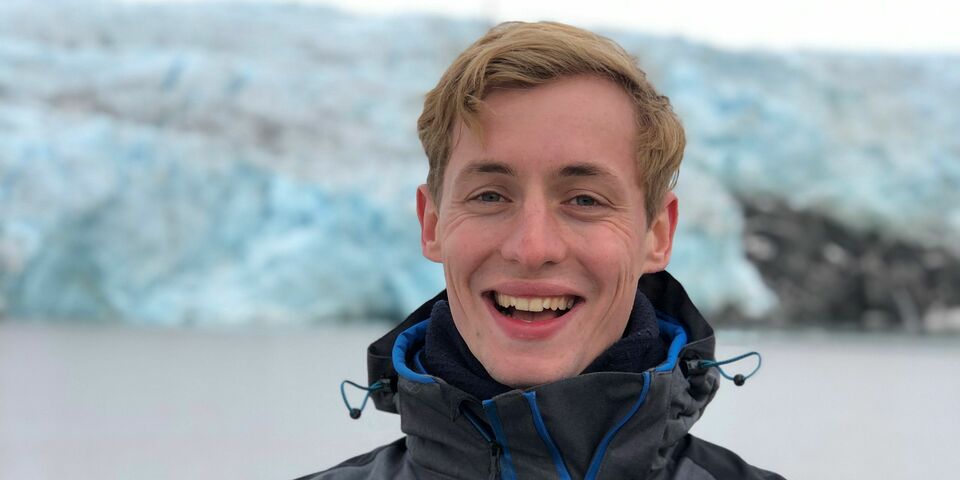And how’s life on Spitsbergen?
Greetings from chilly Spitsbergen, wrote Brandon van Schaik, in a mail to Cursor. For his internship, the master’s student of Sustainable Energy Technology is here building an aircraft drone that will take photographs of the Aurora Borealis, the northern lights. There are worse (and warmer) places to spend an internship. His enthusiasm evident, Van Schaik tells us how he is getting on at the world’s most northern institution of higher education.
“A lecturer named Hjalmar Mulders helped me come to Spitsbergen. This is an island under the sovereignty of Norway, 79o north of the equator. The University Center in Svalbard, UNIS for short, is in the town of Longyearbyen. Research on the northern lights is done at UNIS, among other things. For my internship for my Master’s in Sustainable Energy Technology I am building an aircraft drone that can take photographs during the polar night of the Aurora Borealis, the northern lights. A really cool project, if I say so myself.” Van Schaik is keen to talk about everything that is now possible with the easing of the corona measures.
He estimates that this town of about two thousand residents has roughly 120 student rooms, each accommodating one or two people. “I heard that every year more than a thousand students take the safety training,” Van Schaik tells Cursor on MS Teams.
Polar bear
A number of remarkable adventures await any student who goes to Spitsbergen, he says. “To do most courses here, and any internships, you have to complete various courses on safety. The main one teaches you about polar bear behavior, and is designed to keep you safe, but it is followed by firearms training. You see, when you go beyond Longyearbyen’s street lighting you have to carry a firearm at all times, just in case you come across a polar bear! Pretty much every year someone dies as the result of an incident with a polar bear, so it’s a real danger!”
Van Schaik has not yet seen a polar bear with his own eyes. “They are usually at the coast, but I’m not there all that often. The shooting range is the only place we have fired a gun; no one here wants to shoot a polar bear for real, it’s something you would do only if your life were in danger. Otherwise you use a flare gun with a flashbang charge that explodes very loudly about 100 m away, so that the polar bear is scared off. The last polar bear incident I know of happened last week. We were watching the northern lights from a spot without light pollution when we saw a red flare on the other side of the fjord. That means that someone needs help or that a polar bear has been seen. That was a bit close for comfort given that the fjord was maybe only 2 km wide at that point.”
The fauna isn’t the only worry; the icy seawater should not be underestimated either. Van Schaik and all the other interns are required to take a marine safety course. “We had to jump into the freezing cold fjord wearing a survival suit and attach ourselves securely to each other, so that we could swim to a safe place together. This is in case you fall into the water during an excursion at sea.”
Hiking is Van Schaik’s main leisure activity. It is restricted to the few hours of daylight and means putting spikes under his boots; it is the glaciers that are most slippery. Two glaciers, Longyearbreen and Larsbreen - breen is Norwegian for glacier – are a 45-minute walk from Elvesletta so the students entertain themselves visiting ice caves or climbing to the top of peaks with names like Sarkofagen, Trollsteinen and Sukkertoppen. “And of course we often have parties, but that is the same as in any student house,” he says.
Electric-powered flight
Cursor knows Brandon van Schaik from previous unusual activities; as one of the founders of Falcon Electric Aviation, a student team that converts existing trainer aircraft into electric aircraft, and he is a team member of ABC You Later, which is researching whether electric-powered flight between Curaçao, Aruba and Bonaire is viable.
This quartile Van Schaik is producing a drone with a northern lights camera at UNIS, the institution training the next generation of Artic experts in the fields of biology, geology, geophysics and technology.“I expect to be able to fly the drone in mid-November and December, during three rocket launches taking place to study the northern lights. I hope this will be a chance to collect good data, and perhaps to take some great photos.”
Shortly before Christmas Van Schaik will complete his internship on Spitsbergen and return to the Netherlands. But with mild regret in his heart. “When I arrived, I wondered whether I’d be able to stick it out for three months, but now I’m really keen to come back at some point.” He is also keen to get back to tinkering with an electric aircraft at ABC You Later. “We are going to incorporate new sensors in the Pipistrel Velis Electro so that they can alert us to when maintenance work is needed.” He can imagine wanting to take a PhD once he has his master’s. But that won’t be on Spitsbergen. “I hope someday I’ll come back here as a tourist.”







Discussion